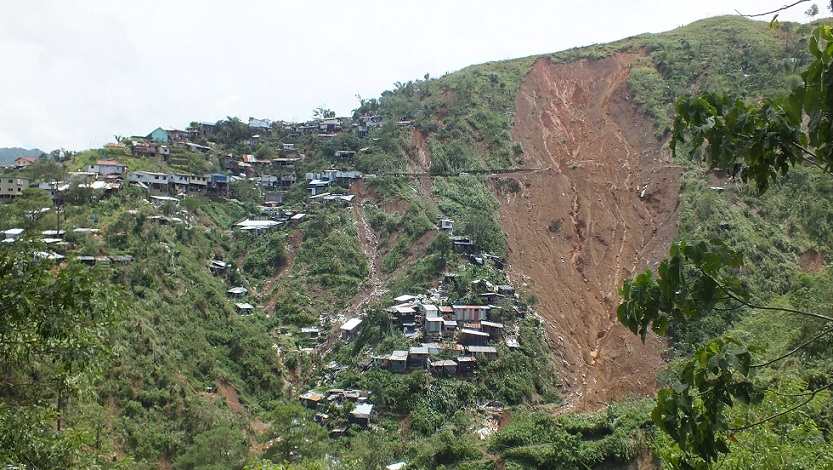
Participants of the Aeta Village roadshow take a break tending their stores at the expo. Photo by Terence Gonzalves.
Aeta leader Rouvilane Margarito had grown up under the shadow of Mt. Pinatubo.
As a young girl, she and her family lived near the US Clark Air Base in Pampanga where she led a life like any modern girl her age. But during weekends and holidays, her father would take her up to his parents’ village in the mountains and deliver her to his mother to be taught the old ways.
“Grandmother made sure we knew the old way of doing things, the old beliefs, how to cook food the way our people did it,” recalled Margarito of those visits to her grandmother who still lives in the old community.
While in the old Aeta village, Margarito experienced to have her head traced by the blunt side of a machete as a protection from lightning during storms. When she gets up from the banana leaf where she’s been napping, grandmother shakes her awake to be certain her soul does not stay asleep. And when Margarito goes back to her home in the lowlands, grandmother makes sure to call out her name while sending the girl home to make sure no part of her being is left behind.
“My grandmother used to slaughter a (pig or cow) monthly and then share it with the village,” she said during a short conversation in the middle of an exposition showcasing traditional Aeta products.
“That’s how they were. They shared with the community freely.”
Merly Bautista, 63 years old, recalled that those who lived inside the former US military base (now Philippine Air Force base) did not want for work.
“You just show up and, if you are kulot, you get a job even if you don’t have an education,” she said, referring to the Aeta’s curly hair that distinguished them from other lowlanders.
The lowlanders were referred to as unat, referring to their straight hair, she said.
In the past, being kulot automatically gave them special treatment in the base.

How the people living in the vicinity of Mt. Pinatubo, including the Aetas, coped with Mt. Pinatubo’s anger 28 years ago. Phivolcs file photo.
But then Mt Pinatubo erupted in 1991, forcing the Aeta tribes of Mabalacat, Porac in Pampanga, and in Zambales, and Tarlac provinces to evacuate their mountainside villages. And, with the lahar or mudflow continuing to devour lands years after the volcano went back to sleep, they remained displaced.
(The U.S. government closed Clark Air Base after it was buried in volcanic ash from Mt Pinatubo’s eruption).
A whole generation of Aetas were born and forced to grow up in evacuation centers in the lowlands. They were exposed to none of the benevolence of Mt Pinatubo’s fertile lands. They and their families knew only of squalid living conditions, hunger, and uncertainty.
Some of them had to resort to begging.
In droves, Aeta families would shuttle to urban centers – Metro Manila in particular – during the Christmas holidays to beg for alms. This has given lowland communities unfamiliar with the Aeta culture the impression that begging is all that Aetas know.
“But not all Aetas are beggars, said Rufina Sanchez, another community elder and one of the original settlers in the foothills of Mt. Pinatubo. “Me, I would never beg. At my age I work for what I have. I would never beg especially for food,” she emphasized.
“Those beggars are from another tribe. Not ours,” she continued. “We’ve always been in the business of selling souvenirs or working at the US base.”

Aetas have been allowed to return to and live on slopes
Pinatubo. Photo by Terence Gonsalves.
Theirs was a proud Aeta race wherein tributes – what lowlanders wrongly interpret as payment – are expected for the performance of traditional songs and dances or even just for the privilege of having their photograph taken.
In fact, Margarito’s grandfather Kudiaro Laxamana was held in such high esteem by the Americans that they built a monument for him inside the base.
As then tribe chieftain, he would be fetched from his home and brought to Clark on a helicopter so he could give jungle survival training to American soldiers. Laxamana is also a decorated World War 2 hero.
As the indigenous people’s representative to the provincial government, Margarito is spearheading a movement to remind the younger generations of Aetas about their rich and proud culture.

An Aeta girl tends to her store in the Aeta Village, a bazaar of Aeta products inside Subic. The bazaar is part of the local government’s efforts to promote the Aeta culture. Photo by Terence Gonzalves.
In 2017 they started a month-long festival showcasing the Aeta culture – traditional fashion, dances, and even games.
“Did you know we have our own version of basketball? But instead of the hoop being just there, the hoop is a basket carried by one of the players and you try to shoot,” Margarito said.
She said that in reviving the culture, she hopes that the younger generations of Aetas, even if they get their hair rebonded as is widely popular, will remain kulot in their hearts.
(This story is produced by VERA Files under a project supported by the Internews’ Earth Journalism Network, which aims to empower journalists from developing countries to cover the environment more effectively. )


